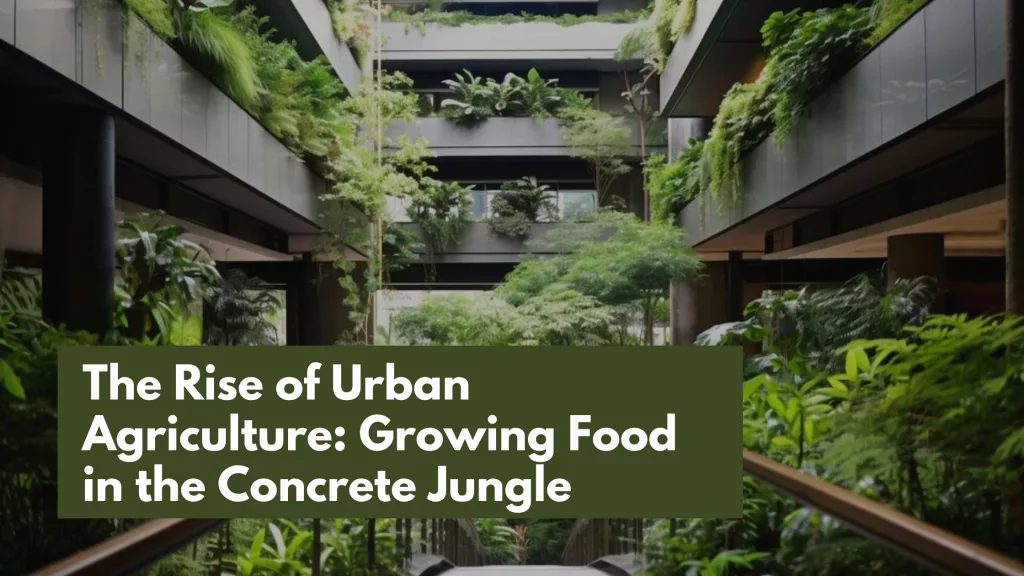What is Climate-smart agriculture?
Climate-smart agriculture (CSA) is an approach that aims to enhance agricultural productivity, increase resilience to climate change, and reduce greenhouse gas emissions. It involves implementing practices and techniques considering climate variability and climate change impacts. CSA integrates three main objectives:
Increasing agricultural productivity and incomes involves adopting innovative and sustainable farming practices to improve crop yields, livestock production, and overall farm profitability.
Adapting and building resilience to climate change: CSA focuses on adapting agricultural systems to withstand the impacts of climate change, such as extreme weather events, droughts, and shifts in rainfall patterns. This may include using drought-tolerant crops, implementing water management techniques, and conserving soil.
Reducing greenhouse gas emissions: CSA seeks to mitigate climate change by reducing emissions from agricultural activities. This can be achieved through optimizing fertilizer use, adopting agroforestry techniques, and implementing efficient livestock management.
Climate-smart agriculture in India
Climate-smart agriculture (CSA) in India aims to address the challenges posed by climate change and promote sustainable agricultural practices. The country has a diverse agricultural sector and is highly vulnerable to climate variability and extreme weather events. Here are some critical aspects of CSA in India:
Climate-resilient crop varieties: The development and promotion of climate-resilient crop varieties, such as drought-tolerant or flood-tolerant, are crucial for adapting agriculture to changing climatic conditions. Initiatives are underway to enhance farmers’ availability and adoption of these varieties.
Water management: Efficient water management techniques, including improved irrigation systems, water harvesting, and watershed management, play a vital role in CSA. These practices help farmers optimize water use, particularly in regions facing water scarcity and changing precipitation patterns.
Soil conservation and management: Soil degradation is a significant concern in Indian agriculture. CSA emphasizes adopting sustainable soil management practices like conservation agriculture, organic farming, and integrated nutrient management to improve soil health, fertility, and moisture retention.
Agroforestry and agroecology: Integrating trees into agricultural systems through agroforestry helps improve ecosystem resilience, biodiversity, and carbon sequestration. Agroecological approaches, such as organic farming and mixed cropping, promote sustainable and climate-resilient agricultural practices.
Climate information and advisory services: Providing farmers with timely climate information, weather forecasts, and advisory services is crucial for informed decision-making and planning. These services enable farmers to adjust their agricultural practices according to climate conditions and minimize weather-related risks.
Capacity building and financial support: Promoting awareness and building the capacity of farmers, extension workers, and other stakeholders is essential for the successful implementation of CSA. Additionally, access to finance, insurance, and credit facilities helps farmers adopt climate-smart practices and recover from climate-related losses.
Importance of climate-smart agriculture
Climate-smart agriculture (CSA) holds significant importance for addressing the challenges posed by climate change and achieving sustainable agricultural development. Here are some key reasons why CSA is important:
Food security: Climate change impacts, such as changing rainfall patterns, extreme weather events, and temperature variations, pose risks to agricultural productivity and food security. CSA practices enhance the resilience of farming systems, helping farmers adapt to climate variability and reduce the risk of crop failures. By improving agricultural productivity and stability, CSA contributes to global food security.
Climate change adaptation: CSA focuses on building the resilience of agricultural systems to climate change impacts. By adopting climate-resilient crop varieties, implementing efficient water management techniques, promoting soil conservation, and integrating trees into agricultural landscapes, CSA helps farmers cope with the challenges of climate change, such as droughts, floods, and heat waves.
Mitigation of greenhouse gas emissions: Agriculture is a significant contributor to greenhouse gas emissions, primarily through the release of methane from livestock and nitrous oxide from fertilizer use. CSA practices, such as optimizing fertilizer application, improving livestock management, and adopting agroforestry, can reduce greenhouse gas emissions from the agricultural sector, thus mitigating climate change.
Sustainable resource management: CSA emphasizes the sustainable management of natural resources, including soil, water, and biodiversity. By promoting conservation agriculture, efficient irrigation, and integrated pest management, CSA helps protect soil fertility, conserve water resources, and enhance biodiversity, ensuring the long-term sustainability of agricultural systems.
Rural livelihoods and poverty reduction: Most of the world’s poor and food-insecure populations reside in rural areas and depend on agriculture. CSA practices, such as improved crop yields, diversified income sources through agroforestry, and access to climate information and advisory services, contribute to rural livelihood enhancement, poverty reduction, and inclusive agricultural development.
Environmental sustainability: Agriculture has a significant impact on the environment, including deforestation, water pollution, and soil degradation. CSA promotes sustainable farming practices that minimize environmental degradation, preserve natural resources, and promote biodiversity conservation. This helps in achieving a more sustainable and environmentally friendly agricultural sector.
List of climate-smart agriculture practices
Conservation agriculture: This practice involves minimizing soil disturbance through reduced tillage or no-till methods, maintaining a permanent soil cover, and crop rotation. It helps improve soil health, moisture retention, and carbon sequestration.
Agroforestry: Integrating trees into agricultural landscapes provides multiple benefits, such as improving soil fertility, enhancing water retention, giving crop shade, and sequestering carbon. Agroforestry systems can include alley cropping, windbreaks, or multi-story cropping.
Diversification of crops and livestock: Planting various crops and integrating livestock into farming systems can enhance resilience to climate variability. Diversification spreads risks and reduces vulnerability to pests, diseases, and climate-related shocks.
Improved water management: Efficient irrigation techniques, such as drip and precision irrigation, minimize water wastage and ensure optimal water use. Water harvesting and storage systems, like ponds or rainwater harvesting structures, help capture and store rainfall for agricultural use.
Climate-resilient crop varieties: Using varieties tolerant to drought, flooding, heat stress, or pests and diseases helps farmers adapt to changing climatic conditions and maintain productivity. Breeding programs and seed systems are crucial in developing and disseminating these varieties.
Integrated pest management (IPM): IPM combines different pest control strategies, such as biological control, cultural practices, and judicious use of pesticides, to manage pests and diseases sustainably. It reduces reliance on chemical pesticides and minimizes their environmental impact.
Precision agriculture: Applying remote sensing, Geographic Information Systems (GIS), and Global Positioning Systems (GPS) allows farmers to optimize input use, such as fertilizers and pesticides, based on specific crop and soil requirements. This precision approach increases efficiency and reduces resource wastage.
Organic farming: Organic farming practices avoid using synthetic fertilizers and pesticides, focusing on natural inputs, crop rotations, and composting. It promotes soil health and biodiversity and reduces environmental pollution.
Livestock management: Improving livestock management practices, such as better feeding and housing, efficient manure management, and biogas systems, helps reduce greenhouse gas emissions from the livestock sector and enhances productivity.
Climate information and advisory services: Providing farmers with timely weather forecasts, climate information, and agronomic advice helps them make informed decisions and adapt their farming practices to changing conditions.
These practices can be tailored to local contexts and combined to create climate-smart agricultural systems that enhance productivity, resilience, and sustainability while reducing greenhouse gas emissions and environmental impact.
How Does Climate Smart Agriculture Ensure Food Security
Climate-smart agriculture (CSA) is crucial in ensuring food security in the face of climate change. Here’s how CSA helps achieve food security:
Increased productivity: CSA practices focus on improving agricultural productivity through climate-resilient crop varieties, sustainable soil management, efficient water use, and optimized nutrient management. Farmers can enhance crop yields and overall agricultural productivity by adopting these practices, increasing food production and availability.
Climate risk management: CSA helps farmers manage climate-related risks and uncertainties. By implementing practices such as crop diversification, agroforestry, and improved water management, farmers can reduce their vulnerability to extreme weather events like droughts, floods, or heatwaves. This enhances their ability to produce food even under challenging climatic conditions.
Enhanced resilience: CSA practices promote the resilience of agricultural systems to climate variability and change. CSA improves soil health, water retention, and biodiversity through conservation agriculture, agroecology, and soil conservation. These resilient farming systems are better equipped to withstand climate-related stresses and maintain food production over the long term.
Adaptive capacity: CSA supports farmers in adapting their agricultural practices to changing climatic conditions. By providing access to climate information and advisory services, farmers can make informed decisions about when to plant, irrigate, and harvest, considering climate forecasts and trends. This adaptive capacity allows farmers to adjust their farming practices and mitigate the potential negative impacts of climate change on food production.
Sustainable resource management: CSA emphasizes sustainable management of natural resources such as soil, water, and biodiversity. Agriculture, organic farming, and agroforestry contribute to soil conservation, water efficiency, and biodiversity conservation. By maintaining the health and productivity of these resources, CSA ensures the long-term sustainability of food production systems.
Reduced greenhouse gas emissions: Climate change mitigation is essential to CSA. By implementing practices that reduce greenhouse gas emissions from agriculture, such as optimized fertilizer use, improved livestock management, and agroforestry, CSA contributes to mitigating climate change. This reduces the negative impacts of climate change on agriculture, preserving food production capacity in the long run.
Conclusion
In conclusion, climate-smart agriculture (CSA) is an approach that addresses the challenges posed by climate change while promoting sustainable and resilient agricultural practices. By integrating adaptation, mitigation, and sustainable resource management strategies, CSA plays a vital role in ensuring food security, enhancing agricultural productivity, and reducing the environmental impact of agriculture.
The Government of India, along with various national and state-level agencies, research institutions, and non-governmental organizations, is actively promoting CSA through policy support, research, and implementation programs to enhance agricultural sustainability and resilience in the face of climate change.



